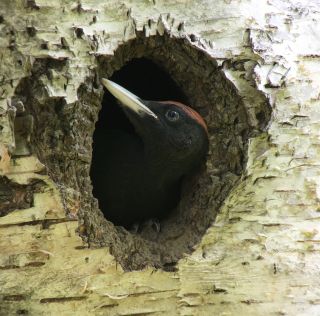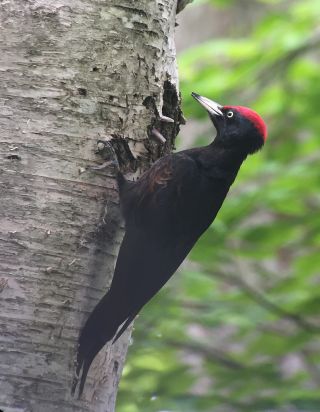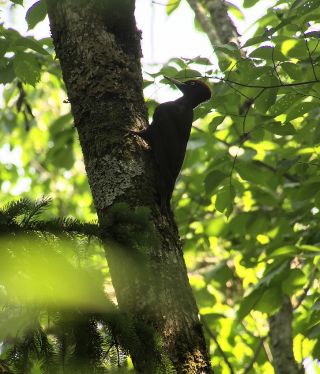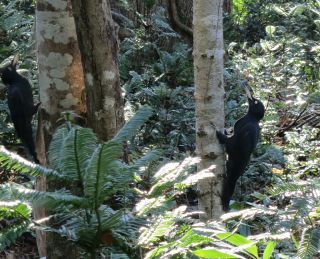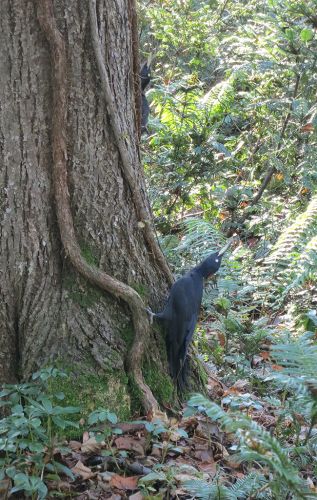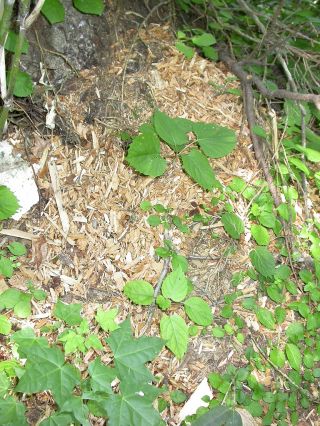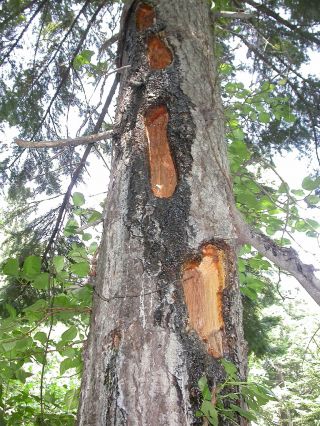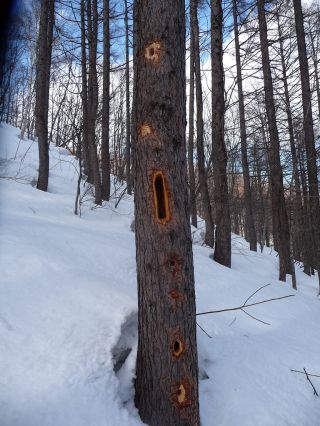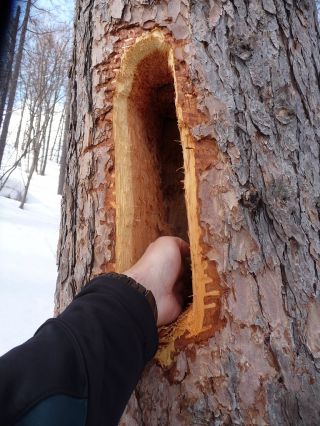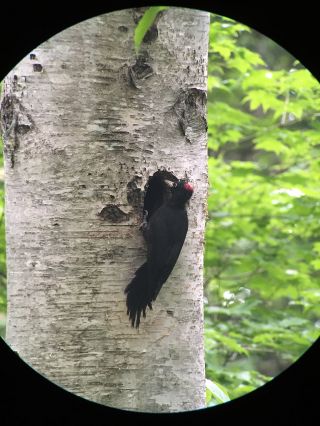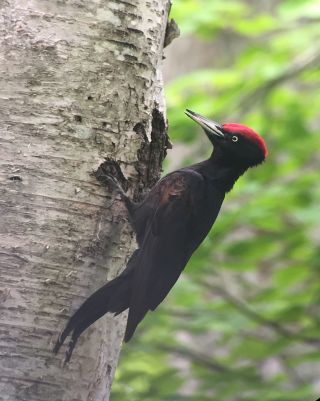A young Black Woodpecker emerges from its nest cavity © Mark Brazil
Kumagera: Japan's Largest Woodpecker
By Mark Brazil | Jun 30, 2017
As mammals we live from before birth to death accompanied by a ceaseless steady rythym. The rhythmic beating of our hearts – though much to my doctor's consternation in my case that rhythm is not so regular. Unlike us mammals, plants operate, flourish, and proliferate without that steady and continuous beating. For them, their rhythms come from the slow annual ticking of the seasons, and the metronomic flickering of light from night to day and back.
Unlike the horological mechanism in which the wound spring drives the second, minute and hour hands at their separate speeds, for our planet’s plant life it is the progressing seasons combined with daily pulses of dark and light that drive their patterns of growth, their phenological achievements. Beyond those patterns, the largest living terrestrial organisms, the trees, sway and creak, their branches move, even rattle and tap at the whim of the wind, until, that is, a rhythm-maker happens along to bring a kind of order to that chaos.
With an upward swoop, a woodpecker ends its undulating flight, grasps bark between strong toes and under sharp claws and braces itself on its stiffened and pointed tail, as if instantly bracketed to the trunk. The woodpecker peers sideways, thrusts a glancing, chiseled blow at the bark and sends detached bark fragments raining down. Whatever was closeted in the moist darkness between bark and trunk is now exposed and is soon sucked in with the woodpecker’s remarkably long tongue.
On dense, living wood, the rhythm-maker’s tapping sounds deep and solid. The sound of each tap lingers in the air only briefly; it is mostly absorbed and muffled by the living tissues of the tree. Shuffling, and with seemingly gravity-defying vertical jumps, the woodpecker makes rapid progress upslope beneath an overhanging limb until it reaches the dried, distal dead portion of the branch. There it braces again. No longer seeking food the woodpecker swings its head in a hard, blurring blow, which rattles and reverberates like the beats of a marching drummer. Seconds pass, then the branch receives another beating, the sound recalls a drum roll on a taught drum skin. Now, at regular intervals this code of knocks and pauses echoes through the dry wood of the tree’s dead limb, almost as if it has its own heartbeat.
Our largest woodpecker, the Black Woodpecker, is crow-like in size and colour, it dwarfs the rest of its tribe here in Japan. Enormous and black as the midnight sky the woodpecker sits motionless, staring out through a baleful and ghostly-white eye. “Sit” seems the only way to describe this strange pose, because of the way it has braced itself, with its limbs akimbo, strong toes widespread, long grapnel-like claws gripping rough bark, resting its weight down the tree’s trunk onto it’s long stiffened tail. It hugs the lower trunk as if appreciating the strength of the bole there and as if relishing the security and shade the trunk gives. In an instant its posture mysteriously changes, from passive shade it morphs, becoming elongate. It gestures suddenly upwards with its long neck and long, blade-like, white bill, as if passing off some pallid signal in the shadows.
This midnight black devil bird now strikes a spectral pose with its eldritch wings outstretched, as if those of a fallen angel greeting its diabolical master. It flicks them closed and open once more, posturing all the while. Suddenly, it presents its stark, ivory-white bill skyward. Now it is as menacing as if it were presenting a drawn sword, and appears all the more threatening accompanied by that livid white-eyed stare.
An instant later a second seemingly identical bird peers out from behind the same trunk explaining in its own nervous pose why the first bird was so tense. It too has its beak ready drawn and it too unfurls its wings, making itself appear larger than life size and more menacing. Together, these two black-clad creatures circle each other and the trunk, threatening, but maintaining a distance between them; ready, yet hesitant. They seem like a pair of medieval knightly combatants about to battle to the death. Yet, with a rapid dance-like series of moves, it is as if they establish their ranks, their affiliations, their strengths and weaknesses and suddenly, without coming to blows at all, the eerie contest is concluded and the devil dancers part, each to its own trunk. Equally as quickly, each returns to using its beak for its main purpose of food gathering.
Living trees quake beneath that powerful beak. I can think of it only as the very hammer of death. Sturdy blows driven from the specially strengthened head force the chisel-like beak deep into the living wood, wounding the tree to the quick and exposing it to the elements. It is the devil bird’s unsolicited invitation to rain, sleet, snow, freeze and thaw, rot and fungal growth, and wood crunching beetle larvae to “enter here.” Unmerciful wood mason, the woodpecker drives sharp blows deep into the heartwood. Does it know that it is creating future dead timber, future access to its own prey? It is as if the devil bird beckons to the elements: “Come one, come all, and bring down this mighty living tower of cellulose; make food for me!”
That weapon-like beak wreaks even greater havoc on dead trees. Like a ham-fisted carpenter armed with mallet and chisel, the woodpecker uses its beak to splinter off wedges and chunks of dry wood. Wood dust and debris are cast out in all directions as it excavates, raining rapid blows of its beak against the wood. It pauses, cocks its head and listens, waiting for the subtle scratching movements of deeply hidden beetle larvae alarmed by the vibrations of the blows. It works at the bole until a deep hole is excavated, then, extruding its long tongue into a narrow crevice, it traps its prey and withdraws it with its hard-tipped tongue. The woodpecker leans ever further into the cavity, driving its beak home with tree-shaking blows and sending a rain of debris out that carpets the ground as it searches for yet more prey. When it finally moves on, I find I can sink my extended hand deep into the resulting hole. All this has been excavated in minutes, and it is not even nesting season.
This great, black devil bird (Black Woodpecker) may be the largest of its kind in the Japanese archipelago, but it is by no means alone. Its smaller brethren can be found from the Yaeyama Islands, between Taiwan and Okinawa, all the way north to Japan’s northernmost cape (Soya Misaki). From the tiny Japanese Pygmy Woodpecker to the enormous Black Woodpecker, all share a propensity to drum loudly on dead wood, to dig cavities in search of prey, to excavate deep nesting holes, but between them they divide up the forest with some specialising on foraging along fine twigs, while others take to the branches and others to the trunks.
The Black Woodpecker of northern Japan is unusual in its predilection for foraging almost at ground level, low on large trunks and on fallen trees. Its loud “kree-ah, kree-ah, kree-ah” call given in flight carries far across the forest, giving away its presence, whereas other species tend to have abrupt sharp notes audible only at much closer range.
Yet when they wish to they can be ghostly silent. Near the nest they are quiet, swooping in like shadows, landing in trees well away from the nest itself at first. They inspect their approach, check out the nest from afar, and only then do they suddenly swoop in and alight beside the cavity. Whereas early in the season they would have hacked inwards sending a rain of wood chips outwards and even carrying beakfulls of debris out, by mid season they arrive with beakfulls of food, beetle larvae mostly, which they thrust into the cavity. So closely are the young stacked in the nesting cavity that it is impossible to count them as they cannot all rest at the entrance at once.
At this nest, after watching their antics for some time, I had convinced myself that there were but two chicks inside, yet even after one had emerged and fledged from the nest I realised that there were still two vying for food at the entrance! Once they left the nest they moved off into the forest with their parents in attendance silent as shadows. They have much to learn about the best trees at which to forage, the best height at which to forage, and the best prey on which to feed, they had just a few weeks to absorb all that knowledge before their parents left them to their own devices and to survive the approaching winter.
Winter is my favourite time to look for woodpeckers, not merely because in leafless trees they are more visibe, but because their sounds carry so well and so far. I recall once hearing a reverberating cannonade of blows in forest in the Akan National Park of east Hokkaido. In the frigid winter air that morning the blows carried far. Skiing closer, I located the bird high in a dead conifer. It was drumming hard on the rotten tree; sliding silently closer on my skis eventually I reached a position where I could rest my ear against the trunk. From far above me a rain of wood chips cascaded down and around me on the snow, while channelled down through the wood itself came the sound of that fusillade of blows. They sounded like the deep throbbing heartbeat of the dying wood.
Outro
If you would like to read more about Japan’s natural (and un-natural) history, then you may enjoy Mark’s collection of essays entitled The Nature of Japan: From Dancing Cranes to Flying Fish.
Author, naturalist, lecturer and expedition leader, Dr Mark Brazil has written his Wild Watch column continuously since April 1982, first in The Japan Times for 33 years, and since 2015 here on this website. All Wild Watch articles dating back to 1999 are archived here for your reading pleasure.
Two handy pocket guides The Common and Iconic Birds of Japan and The Common and Iconic Mammals of Japan have also been published and along with The Nature of Japan are available from www.japannatureguides.com

